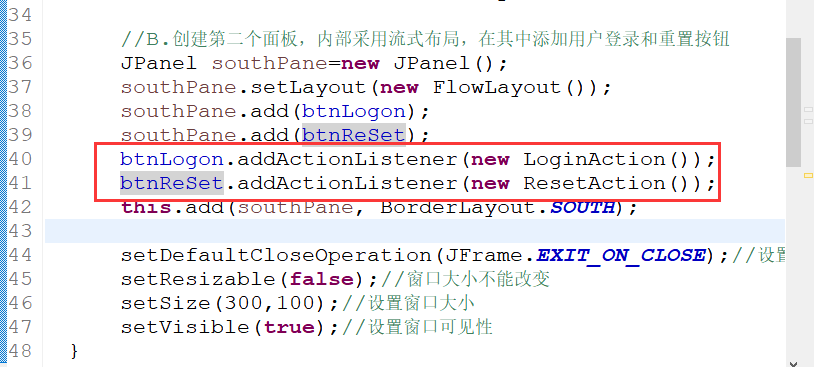商苑面馆:用户登录界面功能实现
来自CloudWiki
(重定向自Java任务:用户登录界面功能实现)
目录
任务描述
完善用户登录界面功能:
登录成功时,弹出成功界面,如图:
失败时,弹出失败界面,如图:
基本实现
创建窗体
具体代码可见 Java任务:购书系统登录窗体的设计
观察有什么事件需要处理
在上述窗体中,有什么事件需要处理呢?
很显然,这个窗体很简单,只有两个按钮的点击事件需要处理。
由前面的知识知道,点击按钮所触发的事件是ActionEvent
我们需要处理ActionEvent事件。
创建事件监听器
接着为其建立监听器。共有两个监听器:一个是登陆按钮的监听器,一个是重置按钮的监听器。
LoginAction:
private class LoginAction implements ActionListener{
public LoginAction(){
}
@Override
public void actionPerformed(ActionEvent e) {
// 获取用户输入的账号和密码
String uid = txtUserID.getText();
String pwd = new String(txtPassword.getPassword());
JOptionPane.showMessageDialog(null, uid+","+pwd, "信息", JOptionPane.INFORMATION_MESSAGE);
}
}
ResetAction:
private class ResetAction implements ActionListener{
public ResetAction(){
}
@Override
public void actionPerformed(ActionEvent e) {
txtUserID.setText("");
txtPassword.setText("");
txtUserID.requestFocus();
}
}
绑定事件监听器
btnLogon.addActionListener(new LoginAction()); btnSet.addActionListener(new ResetAction());
写一个main方法,测试运行
public static void main(String[] args) {
UserInfo userInfo=new UserInfo();
}
简化实现(Lambda表达式)
在学了Lambda表达式,上述代码还可以这样写,不用单独定义事件监听器了,直接写一个匿名的表达式:
package main;
import java.awt.*;
import java.awt.event.ActionEvent;
import java.awt.event.ActionListener;
import javax.swing.*;
public class UserForm extends JFrame{
private JLabel labelUser=new JLabel("用户登录",JLabel.CENTER);
private JLabel labelPwd= new JLabel("登录密码",JLabel.CENTER);//“登录密码”标签
private JTextField txtUserID = new JTextField(16);//“登录账号”文本框
private JPasswordField txtPassword=new JPasswordField(16);//密码框
private JLabel labelUser2=new JLabel("@126.com",JLabel.CENTER);
private JButton btnLogon =new JButton("登陆");//登录按钮
private JButton btnReset = new JButton("重置");//重置按钮
public UserForm() {
this.setTitle("商苑面馆-用户登陆");
//A.创建第一个面板,内部采用网格布局,在其中添加用户登录、用户密码控件
JPanel centerPane=new JPanel();
centerPane.setLayout(new GridLayout(2,2));//步骤1:创建网格布局
centerPane.add(labelUser);//步骤2:将组件添加到面板上
centerPane.add(txtUserID);
centerPane.add(labelPwd);
centerPane.add(txtPassword);
this.add(centerPane, BorderLayout.CENTER);
//步骤3:以边界布局的方式,将面板整体添加到框架上
//B.创建第二个面板,内部采用流式布局,在其中添加用户登录和重置按钮
JPanel southPane=new JPanel();
southPane.setLayout(new FlowLayout());
southPane.add(btnLogon);
southPane.add(btnReset);
//直接用lambda表达式写事件监听器,点击登陆按钮之后显示信息
btnLogon.addActionListener(e ->{
String uid = txtUserID.getText();
String pwd = new String(txtPassword.getPassword());
JOptionPane.showMessageDialog(null, uid+","+pwd, "信息", JOptionPane.INFORMATION_MESSAGE);
});
//直接用lambda表达式写事件监听器,点击登陆按钮之后显示信息
btnReset.addActionListener(e ->{
txtUserID.setText("");
txtPassword.setText("");
txtUserID.requestFocus();
});
this.add(southPane,BorderLayout.SOUTH);
this.setDefaultCloseOperation(JFrame.EXIT_ON_CLOSE);
this.setSize(300,150);
this.setVisible(true);
this.setLayout(new BorderLayout());//为框架上的面板设立布局方式,设为边界布局
this.setLocationRelativeTo(null);//将窗口设为中央
}
public static void main(String[] args) {
// TODO Auto-generated method stub
UserForm userForm=new UserForm();
}
}
返回 Java程序设计


